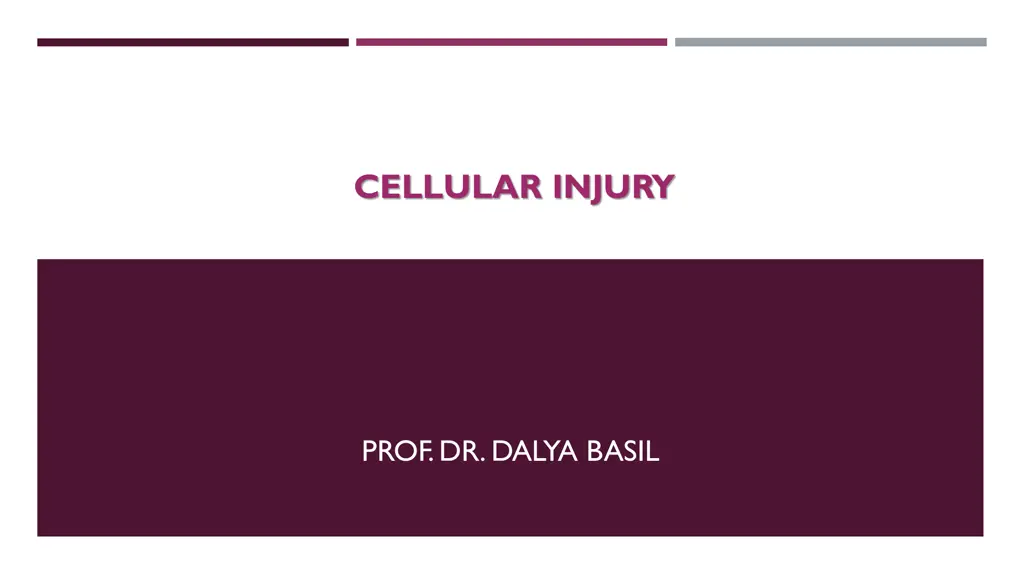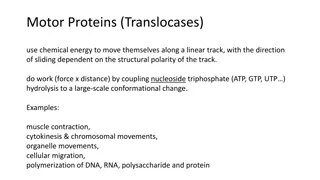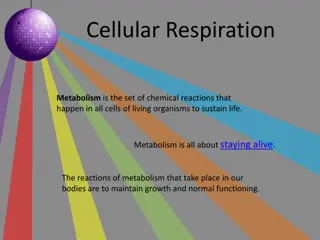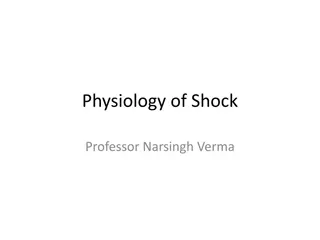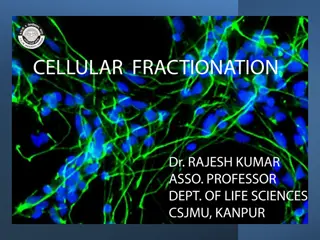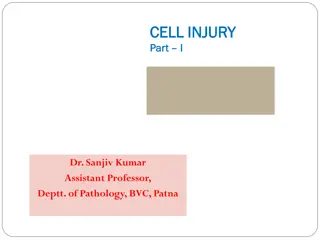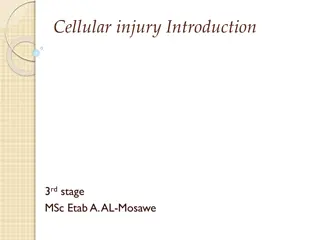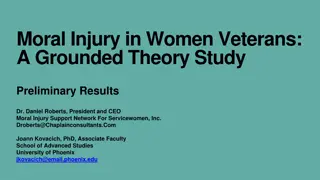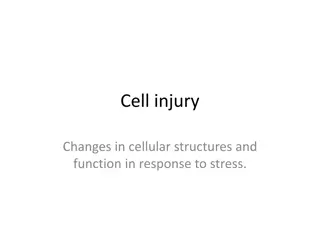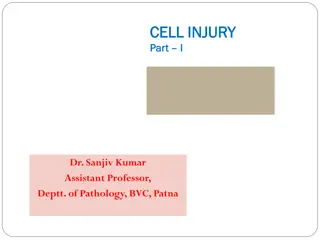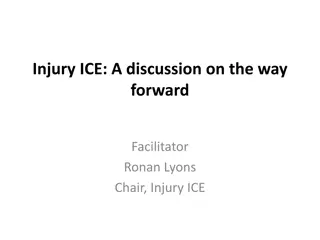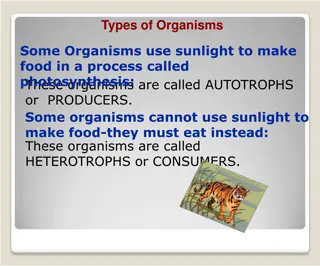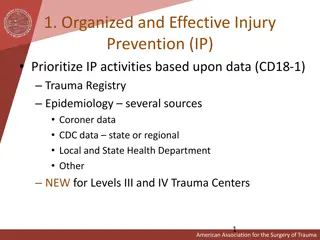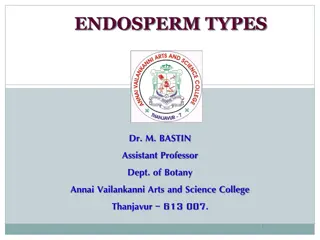Cellular Injury and its Causes
Cellular injury and its causes. This article explores different ways cells can be injured, including physical agents, radiation, chemicals, biologic agents, and nutritional imbalances.
Download Presentation

Please find below an Image/Link to download the presentation.
The content on the website is provided AS IS for your information and personal use only. It may not be sold, licensed, or shared on other websites without obtaining consent from the author. Download presentation by click this link. If you encounter any issues during the download, it is possible that the publisher has removed the file from their server.
E N D
Presentation Transcript
CELLULAR INJURY PROF. DR. DALYA BASIL
CELLULAR INJURY Cellular injury can occur in a number of different ways. The extent of injury that cells experience is often related to the intensity and duration of exposure to the injurious event or substance. Cellular injury may be a reversible process, in which case the cells can recover their normal function, or it may be irreversible and lead to cell death.
CELLULAR INJURY Causes of Cell Injury Cell damage can occur in many ways (the ways by which cells are injured have been grouped into five categories): (1) injury from physical agents (2) radiation injury (3) chemical injury (4) injury from biologic agents (5) injury from nutritional imbalances.
CELLULAR INJURY Injury from PhysicalAgents: Physical agents responsible for cell and tissue injury include mechanical forces (occurs as the result of body impact with another object, these types of injuries split and tear tissue, fracture bones, injure blood vessels, and disrupt blood flow), extremes of temperature, (Extremes of heat and cold cause damage to the cell, its organelles, and its enzyme systems). Exposure to low-intensity heat 43 C to 46 C, such as occurs with partial-thickness burns and severe heat stroke, causes cell injury by inducing vascular injury,and disrupting the cell membrane.With more intense heat, coagulation of blood vessels and tissue proteins occurs. Exposure to cold increases blood viscosity and induces vasoconstriction by direct action on blood vessels and through reflex activity of the sympathetic nervous system, and this will lead to hypoxic tissue injury, depending on the degree and duration of cold exposure.
CELLULAR INJURY Injuries due to electrical forces: Can affect the body through extensive tissue injury and disruption of neural and cardiac impulses.The effect of electricity on the body is mainly determined by its voltage,the type of current (i.e.,direct or alternating),its amperage,the resistance of the intervening tissue,the pathway of the current,and the duration of exposure. Electrical burn of the skin. The victim was electrocuted after attempting to stop a fall from a ladder by grasping a high-voltage line.
CELLULAR INJURY Radiation Injury: Ionizing Radiation: Ionizing radiation affects cells by causing ionization of molecules and atoms in the cell, by directly hitting the target molecules in the cell, or by producing free radicals that interact with critical cell components. It can immediately kill cells, interrupt cell replication, or cause a variety of genetic mutations, which may or may not be lethal. Most radiation injury is caused by localized irradiation that is used in the treatment of cancer.
CELLULAR INJURY The injurious effects of ionizing radiation vary with the dose, dose rate, and the differential sensitivity of the exposed tissue to radiation injury. Because of the effect on deoxyribonucleic acid (DNA) synthesis and interference with mitosis, rapidly dividing cells of the bone marrow and intestine are much more vulnerable to radiation injury than tissues such as bone and skeletal muscle. Many of the clinical manifestations of radiation injury result from acute cell injury, dose-dependent changes in the blood vessels that supply the irradiated tissues,and fibrotic tissue replacement.
CELLULAR INJURY Ultraviolet Radiation: UV radiation contains increasingly energetic rays that are powerful enough to disrupt intracellular bonds and cause sunburn and increase the risk of skin cancers. Skin damage induced by UV radiation is thought to be caused by reactive oxygen species and by damage to melanin-producing processes in the skin. Nonionizing Radiation: Nonionizing radiation includes infrared light, ultrasound,microwaves,and laser energy.Nonionizing radiation exerts its effects by causing vibration and rotation of atoms and molecules.
CELLULAR INJURY Chemical Injury: Chemical agents can injure the cell membrane and other cell structures, block enzymatic pathways, coagulate cell proteins, and disrupt the osmotic and ionic balance of the cell. Corrosive substances such as strong acids and bases destroy cells as the substances come into contact with the body. Other chemicals may injure cells in the process of metabolism or elimination. Carbon tetrachloride (CCl4), for example, causes little damage until it is metabolized by liver enzymes to a highly reactive free radical carbon tetrachloride (CCl3). Carbon tetrachloride is extremely toxic to liver cells.
CELLULAR INJURY Drugs. Many drugs alcohol, prescription drugs, over-the-counter drugs, and street drugs are capable of directly or indirectly damaging tissues. Ethyl alcohol can harm the gastric mucosa, liver, developing fetus, and other organs. Antineoplastic (anticancer) and immunosuppressant drugs can directly injure cells. Other drugs produce metabolic end products that are toxic to cells. Acetaminophen, a commonly used over-the-counter analgesic drug, is detoxified in the liver, where small amounts of the drug are converted to a highly toxic metabolite.This metabolite is detoxified by a metabolic pathway that uses a substance (i.e., glutathione) normally present in the liver. When large amounts of the drug are ingested, this pathway becomes overwhelmed and toxic metabolites accumulate, causing massive liver necrosis.
CELLULAR INJURY Injury from BiologicAgents: Biologic agents are able to replicate and can continue to produce their injurious effects, biologic agents injure cells by diverse mechanisms. Viruses enter the cell and become incorporated into its DNA synthetic machinery. Certain bacteria elaborate exotoxins that interfere with cellular production of ATP. Other bacteria, such as the gram-negative bacilli, release endotoxins that cause cell injury and increased capillary permeability.
CELLULAR INJURY Injury from Nutritional Imbalances: Nutritional excesses and nutritional deficiencies predispose cells to injury. Obesity and diets high in saturated fats are thought to predispose persons to atherosclerosis. The body requires more than 60 organic and inorganic substances in amounts ranging from micrograms to grams.These nutrients include minerals,vitamins,certain fatty acids, and specific amino acids. Dietary deficiencies can occur in the form of starvation, in which there is a deficiency of all nutrients and vitamins, or because of a selective deficiency of a single nutrient or vitamin. Iron-deficiency anemia, scurvy, beriberi, and pellagra are examples of injury caused by a lack of specific vitamins or minerals. The protein and calorie deficiencies that occur with starvation cause widespread tissue damage.
BERIBERI DISEASE PELLAGRA DISEASE
MECHANISMS OF CELLULAR INJURY Mechanisms of Cell Injury There seem to be at least three major mechanisms whereby most injurious agents exert their effects: free radical formation hypoxia andATP depletion disruption of intracellular calcium homeostasis
MECHANISMS OF CELLULAR INJURY Free radical formation: Free radicals are highly reactive chemical species that have one or more unpaired electrons in their outer shell. Examples of free radicals include superoxide (O2 ), hydroxyl radicals (OH ) and hydrogen peroxide (H2O2). Free radicals are generated as by-products of normal cell metabolism and are inactivated by free radical scavenging enzymes within the body such as catalase and glutathione peroxidase. When excess free radicals are formed from exogenous sources or the free radical protective mechanisms fail,injury to cells can occur.
MECHANISMS OF CELLULAR INJURY Free radicals are highly reactive and can injure cells through: 1. Peroxidation of membrane lipids 2. Damage of cellular proteins 3. Mutation of cellular DNA Exogenous sources of free radicals include tobacco smoke, organic solvents, pollutants,radiation and pesticides. Free radical injury has been implicated as playing a key role in the normal aging process as well as in a number of disease states such as diabetes mellitus, cancer, atheroscelrosis, Alzheimer s disease and rheumatoid arthritis.
MECHANISMS OF CELLULAR INJURY Hypoxic cell injury: Hypoxia is a lack of oxygen in cells and tissues that generally results from ischemia. During periods of hypoxia, aerobic metabolism of the cells begins to fail. This loss of aerobic metabolism leads to dramatic decreases in energy production (ATP) within the cells.Hypoxic cells begin to swell as energy-driven processes (such as ATP-driven ion pumps) begin to fail. The pH of the extracellular environment begins to decrease as waste products (such as lactic acid, a product of anaerobic metabolism) begin to accumulate. The cellular injury process may be reversible, if oxygen is quickly restored, or irreversible and lead to cell death. Certain tissues such as the brain are particularly sensitive to hypoxic injury. Death of brain tissues can occur only 4 to 6 minutes after hypoxia begins.
MECHANISMS OF CELLULAR INJURY Disruption of intracellular calcium homeostasis: The loss of ionic balance in hypoxic cells can also lead to the accumulation of intracellular calcium, which is normally closely regulated within cells.There are a number of calcium-dependent protease enzymes present within cells that become activated in the presence of excess calcium and begin to digest important cellular constituents.
OUTCOMES OF CELLULAR INJURY The outcomes of cell injury: reversible cell injury, apoptosis (programmed cell death), cell removing,and necrosis. Reversible cell injury: Reversible cell injury, although impairing cell function, does not result in cell death. Two patterns of reversible cell injury can be observed under the microscope:cellular swelling and fatty change. 1. Cellular swelling: occurs with impairment of the energy-dependent Na+/K+- ATPase membrane pump,usually as the result of hypoxic cell injury. 2.Fatty changes: are linked to intracellular accumulation of fat. When fatty changes occur, small vacuoles of fat disperse throughout the cytoplasm. The process is usually more ominous than cellular swelling, and although it is reversible, it usually indicates severe injury.
OUTCOMES OF CELLULAR INJURY These fatty changes may occur because normal cells are presented with an increased fat load or because injured cells are unable to metabolize the fat properly. In obese persons, fatty infiltrates often occur within and between the cells of the liver and heart because of an increased fat load. Pathways for fat metabolism may be impaired during cell injury, and fat may accumulate in the cell as production exceeds use and export. The liver, where most fats are synthesized and metabolized, is particularly susceptible to fatty change, but fatty changes may also occur in the kidney, the heart, and other organs.
PROGRAMMED CELL DEATH Programmed Cell Death: In most normal non-tumor cells, the number of cells in tissues is regulated by balancing cell proliferation and cell death. Cell death occurs by necrosis or a form of programmed cell death called apoptosis. Apoptosis is a highly selective process that eliminates injured and aged cells, thereby controlling tissue regeneration. Cells undergoing apoptosis have characteristic morphologic features, as well as biochemical changes. Shrinking and condensation of the nucleus and cytoplasm occur.
PROGRAMMED CELL DEATH The fragmentation occurs. Then, the cell becomes fragmented into multiple apoptotic bodies in a manner that maintains the integrity of the plasma membrane and does not initiate inflammation. Changes in the plasma membrane induce phagocytosis of the apoptotic bodies by macrophages and other cells,thereby completing the degradation process. chromatin aggregates at the nuclear envelope, and DNA
PROGRAMMED CELL DEATH Apoptosis is thought to be responsible for several normal physiologic processes, including the programmed destruction of cells during embryonic development, hormone-dependent involution of tissues,death of immune cells, cell death by cytotoxic T cells, and cell death in proliferating cell populations.
PROGRAMMED CELL DEATH Apoptosis is linked to many pathologic processes and diseases. For example, interference with apoptosis is known to be a mechanism that contributes to carcinogenesis. Apoptosis is also known to be involved in the cell death associated with viral infections, such as hepatitis B and C. Apoptosis may also be implicated in neurodegenerative disorders such as Alzheimer disease, and Parkinson mechanisms involved in these diseases remains under investigation. disease. However, the exact
NECROSIS Necrosis refers to cell death in an organ or tissue that is still part of a living person. Necrosis differs from apoptosis in that it involves unregulated enzymatic digestion of cell components, loss of cell membrane integrity with uncontrolled release of the products of cell death into the intracellular space, and initiation of the inflammatory response.In contrast to apoptosis,which functions in removing cells so new cells can replace them,necrosis often interferes with cell replacement and tissue regeneration.
NECROSIS Necrosis includes cytoplasmic as well as nuclear changes Cytoplasmic changes: in hematoxylin-eosin stain (H&E stain) hematoxylin stains the acidic cell materials (nucleus) blue whereas eosin stains alkaline cell materials (cytoplasm) pink. Necrotic cells cytoplasm becomes more alkaline and stains deeply with eosin (eosinophilic) than viable cells because: Loss of cytoplasmic RNA (RNA acidic material) and increase binding of eosin to denatured protein. Nuclear changes: include chromatin clumping (chromatin aggregation) which is the earliest nuclear changes. After that nucleus either shrinks and transformed to a wrinkled mass (pyknosis) with subsequent disintegration of chromatin and disappearance of nucleus (karyolysis). Or the nucleus breaks into many clumps (karyorrhexis).
NECROSIS Types of cell Necrosis: A/ Coagulative necrosis: result from sudden sever ischemia in organs such as heart, kidney,and other organs B/ Liquefactive necrosis: characterized by complete digestion of dead cells by enzymes and the lesion converted into cyst filled with debris. It was seen in Brain infarction,and abscess that occur after suppurative bacterial infection.
NECROSIS C/ Fat necrosis: specific pattern of cell death seen in adipose tissue due to action of lipase enzyme as in acute pancreatitis.Also can be seen after trauma of fatty tissue e.g.of trauma of female breast. D/ Caseous necrosis (caseation): have the combined features of both coagulative and liquefactive necrosis seen in the center ofTB granuloma. E/ Gangrenous necrosis: it is surgical term represents combination of coagulative necrosis (ischemia) of tissue followed by liquefactive necrosis by liquefactive action of enzymes derived from bacteria and inflammatory cells.
GANGRENE Gangrene is classified into 3 types: 1. Dry gangrene 2. Wet gangrene 3. Gas gangrene
GAS GANGRENE IS CAUSED BY BACTERIA CALLED CLOSTRIDIUM. THIS IS FOUND IN SPORES PRESENT IN THE SOIL.
MANIFESTATION OF CELLULAR INJURY 1. Cellular swelling: Caused by an accumulation of water due to the failure of energy-driven ion pumps. Breakdown of cell membrane integrity and accumulation of cellular electrolytes may also occur. Cellular swelling is considered to be a reversible change. 2.Cellular accumulations: In addition to water, injured cells can accumulate a number of different substances as metabolism and transport processes begin to fail.Substances that can be accumulated in injured cells may include fats, proteins, glycogen, calcium, uric acid and certain pigments such as melanin. These accumulations are generally reversible,accumulation of these substances can be so marked that enlargement of a tissue or organ may occur (for example,fatty accumulation in an injured liver).When cells are irreversibly injured and dying, specific nuclear changes may be visible, including pyknosis, karyorrhexis,and karyolysis.If large numbers of cells die,tissue necrosis may occur.
REFERENCE Essential of Pathophysiology, Concepts of Altered Health States, 3rdEdition, Carol Mattson Porth (2010).
